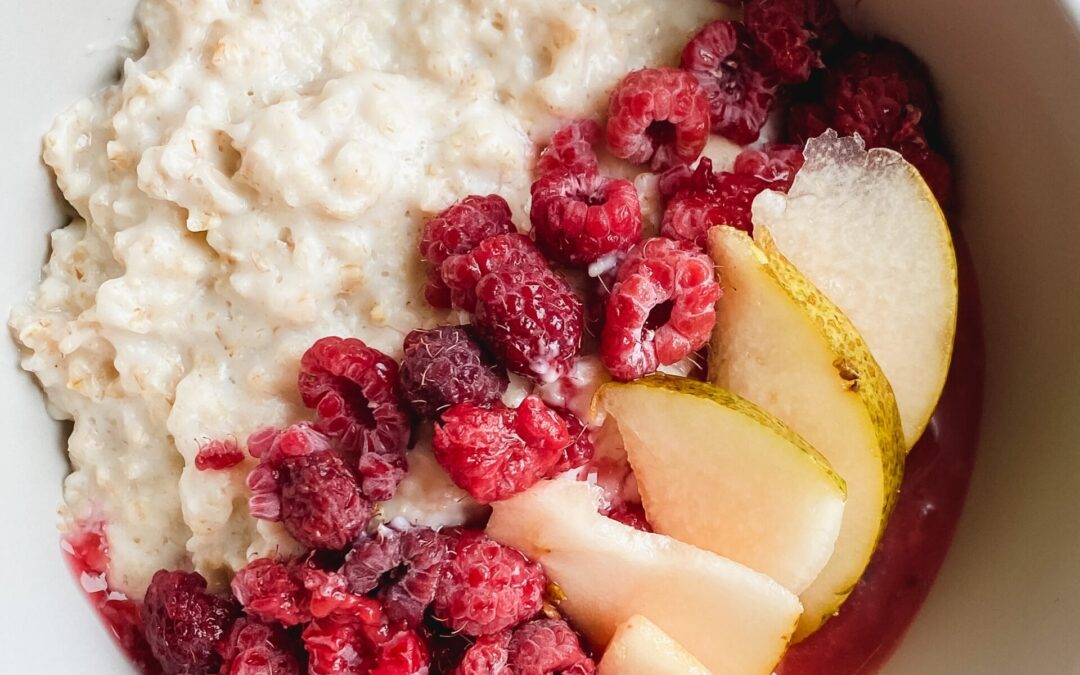Eating a diet high in fiber is best known to prevent or relieve constipation. However, fiber contains loads of amazing health benefits. It can help maintain a healthy weight, lower risks of diabetes and heart disease, and lower cholesterol levels. Fiber also helps to regulate the body’s use of sugars, which keeps hunger and blood sugar in check.
Fiber is in a lot of whole foods from fruits, vegetables, to grains! We have seen a rise in people not wanting to eat grains and breads due to popular diet culture. This may be for diet reasons or due to allergies. But grains aren’t bad for you. In fact, they hold a lot of needed nutrients like soluble and insoluble fiber. What we don’t want is over-processed breads and other foods. Fiber from grains can make us feel more full and digest our food more easily.
Tips to Increase Fiber Intake:
- Snack on whole fruits instead of drinking fruit juices.
- Replace white pasta, bread, and rice with brown rice and whole grain products.
- Snack on raw vegetables instead of chips, crackers, or chocolate.
- Replace meat with beans or legumes two or three times per week.
Fiber Feeds Your Gut Bacteria
Your gastrointestinal tract is home to trillions of beneficial microbes. These microbes need to eat to survive and grow, so they obtain nourishment from the undigested part of the food, (fiber), that is passing through your intestines by fermenting it. The type of fiber that promotes growth of the intestinal microbiome is called prebiotic fibers. Not all fiber is considered prebiotic.
The gut microbiome fuels immunity and prevents disease.The good bacteria compete for space in the intestines, blocking the disease-causing bacteria from taking hold.
Reasons to Eat More Fiber:
Fiber Keeps You More Full
Due to fiber being hard to break down. It stays in the gastrointestinal tract longer compared to simple carbohydrates or fruit. Some studies have shown that high-fiber diets help you eat less, which can impact weight loss or gain. Foods high in protein and fiber are more satiating.
Fiber Helps Lower Your Risk for Heart Disease.
High intake of dietary fiber has been linked to lower risk of heart disease in large studies done. Eating a diet high in fiber is associated with lower risk of cardiovascular disease, mostly because it helps reduce “bad” cholesterol (LDL).
Fiber Reduces Constipation and Promotes Healthy Elimination.
Constipation is one of the most common gastrointestinal complaints in the U.S. The consumption of fiber seems to reduce and prevent constipation.
Fiber helps you have better elimination through several mechanisms that increase the weight of the stool, making it easier to pass. Insoluble fiber adds bulk to the stool making the stool larger. Insoluble fibers absorb water and soften the stool for easy elimination
Fiber Supports Healthy Blood Sugar Levels and Lowers the Risk of Type 2 Diabetes.
Eating meals with mostly sugar or simple carbohydrates can cause a spike and drop in your blood sugar levels. Meals with high fiber can help slow down the emptying of the stomach, resulting in a trickle of sugar into the bloodstream.
A slower release of sugar into the blood stream maintains a constant energy stream, rather than energy peaks and drops. Whole grains, legumes, fruits, and veggies as your carbohydrate sources work to support a healthy blood glucose levels.
How Much Fiber Do We Need?
The Institute of Medicine recommends that adult men consume around 30-38g of fiber per day and adult women consume 21-25g per day for optimal health. Children and adults need at least 20 to 30 grams of fiber per day for good health, according to Harvard School of Public Health. Yet, most Americans get less than 15 grams a day. If you have a low fiber diet, increase your intake slowly and gradually. If you increase the fiber intake drastically, you may experience some gas, cramping, and bloating.
Some Options to Add Into Your Diet
- Fresh Fruits: All fruits tend to be high in fiber. Apples, berries, figs, and pears are especially high in fiber.
- Leafy Greens:Spinach, kale, or collard greens sautéed, tossed into a salad, or blended into a smoothie boost your fiber levels and give you extra vitamins and minerals.
- Fresh Vegetables: All vegetables are great. Brussels sprouts, artichokes, and turnips hare high in fiber.
- Whole Grains: Whole grains leave the full grain intact and includes the bran, germ, and endosperm. Old-fashioned oats, quinoa, or wheat berries are very satiating and full of fiber!
- Nuts and Seeds: Almonds, pistachios, pumpkin seeds, and other nuts are great to get fiber and have a healthy dosage of fats and proteins! We also recommend adding chia seeds and flax seed to oatmeal or smoothies.
6.8.2022
